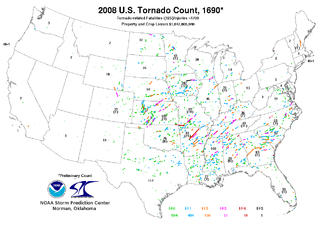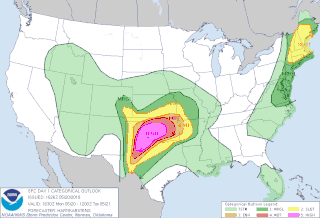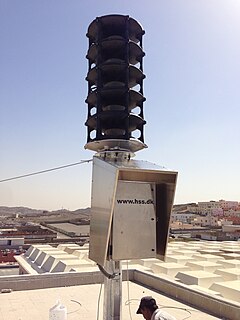
This page documents the tornadoes and tornado outbreaks that occurred in 2007, primarily in the United States. Most tornadoes form in the U.S., although some events may take place internationally, particularly in parts of neighboring southern Canada during the summer season. Some tornadoes also take place in Europe, e. g. in the United Kingdom or in Germany.

This page documents notable tornadoes and tornado outbreaks worldwide in 2008. Strong and destructive tornadoes form most frequently in the United States, Bangladesh, and Eastern India, but they can occur almost anywhere under the right conditions. Tornadoes also develop occasionally in southern Canada during the Northern Hemisphere's summer and somewhat regularly at other times of the year across Europe, Asia, and Australia. Tornadic events are often accompanied with other forms of severe weather, including strong thunderstorms, strong winds, and hail.

The Tornado outbreak of May 1–2, 2008 was a tornado outbreak that took place across the Southern and Central United States on May 1 and May 2, 2008. The outbreak was responsible for at least seven fatalities and 23 injuries in Arkansas. There were at least 29 tornado reports from Iowa to Oklahoma on May 1 and 67 more in Arkansas, Missouri, Mississippi, Tennessee, Louisiana and Texas on May 2. At least 63 tornadoes were confirmed by weather authorities.

In 2009, tornadic activity was generally near average. Each year, tornadoes and tornado outbreaks occur worldwide primarily under conductive conditions, though a majority of tornadoes form in the United States. Tornadoes also occur to a less frequent extent in Europe, Asia, and Australia. In the U.S., there were 1,304 reports of tornadoes received by the Storm Prediction Center (SPC), and 1,159 tornadoes were confirmed to have taken place. Worldwide, 45 fatalities were caused by tornadoes, with 22 in the U.S., 15 in India, four in Canada, two in Greece and one each in Serbia and Russia.

The May 10–13, 2010 tornado outbreak was a major tornado outbreak that affected large areas of Oklahoma, Kansas, Missouri, and Arkansas, with the bulk of the activity in central and eastern Oklahoma. Over 60 tornadoes, some large and multiple-vortex in nature, affected large parts of Oklahoma and adjacent parts of southern Kansas and Missouri, with the most destructive tornadoes causing severe damage in southern suburbs of the Oklahoma City metropolitan area and just east of Norman, Oklahoma, where the fatalities were reported from both tornado tracks. The outbreak was responsible for three fatalities, all of which occurred in Oklahoma. Damage was estimated to be over $595 million in central Oklahoma alone.

The 2010 New Year's Eve tornado outbreak was a three-day-long tornado outbreak that impacted the central and lower Mississippi Valley from December 30, 2010 to January 1, 2011. Associated with a low pressure system and a strong cold front, 37 tornadoes tracked across five states over the length of the severe event, killing nine and injuring several others. Activity was centered in the states of Missouri and later Mississippi on December 31. Seven tornadoes were rated EF3 on the Enhanced Fujita Scale; these were the strongest during the outbreak. Non-tornadic winds were recorded to have reached as high as 80 mph (130 km/h) at eight locations on December 31, while hail as large as 2.75 in (7.0 cm) was documented north-northeast of Mansfield, Missouri. Overall, damage from the outbreak totaled US$123.3 million, most of which was related to tornadoes.

This page documents the tornadoes and tornado outbreaks of 2012. Extremely destructive tornadoes form most frequently in the U.S., Bangladesh, Brazil and Eastern India, but they can occur almost anywhere under the right conditions. Tornadoes also appear regularly in neighboring southern Canada during the Northern Hemisphere's summer season, and somewhat regularly in Europe, Asia, Argentina, and Australia.

From April 13–16, 2012, a major tornado outbreak occurred across a large portion of the Great Plains. The storms resulted in 6 tornado-related fatalities, all of which occurred as a result of a nighttime EF3 tornado that caused major damage in and around Woodward, Oklahoma. Numerous other tornadoes occurred, including a violent EF4 tornado that passed near Marquette, Kansas, and an EF3 that caused major damage in Wichita.

The tornado outbreak of May 18–21, 2013 was a significant tornado outbreak that affected parts of the Midwestern United States and lower Great Plains. This event occurred just days after a deadly outbreak struck Texas and surrounding southern states on May 15. On May 16, a slow moving trough crossed the Rockies and traversed the western Great Plains. Initially, activity was limited to scattered severe storms; however, by May 18, the threat for organized severe thunderstorms and tornadoes greatly increased. A few tornadoes touched down that day in Kansas and Nebraska, including an EF4 near Rozel, Kansas. Maintaining its slow eastward movement, the system produced another round of severe weather nearby. Activity significantly increased on May 19, with tornadoes confirmed in Oklahoma, Kansas, Iowa, Missouri, and Illinois. In Oklahoma, two strong tornadoes, one rated EF4, caused significant damage in rural areas of the eastern Oklahoma City metropolitan area; two people lost their lives near Shawnee. The most dramatic events unfolded on May 20 as a large EF5 tornado devastated parts of Moore, Oklahoma, killing 24 people. Thousands of structures were destroyed, with many being completely flattened. Several other tornadoes occurred during the day in areas further eastward, though the majority were weak and caused little damage.

On the afternoon of Monday, May 20, 2013, a large and extremely powerful EF5 tornado ravaged Moore, Oklahoma, and adjacent areas, with peak winds estimated at 210 mph (340 km/h), killing 24 people and injuring 212 others. The tornado was part of a larger weather system that had produced several other tornadoes across the Great Plains over the previous two days, including five that struck portions of Central Oklahoma the day prior on May 19.

The El Reno tornado was a very large EF3 tornado that occurred over rural areas of Central Oklahoma during the early evening of Friday, May 31, 2013. The widest tornado in recorded history, it was part of a larger weather system that produced dozens of tornadoes over the preceding days. The tornado initially touched down at 6:03 p.m. Central Daylight Time (2303 UTC) about 8.3 miles (13.4 km) west-southwest of El Reno, rapidly growing in size and becoming more violent as it tracked through central portions of Canadian County. Remaining over mostly open terrain, the tornado did not impact many structures; however, measurements from mobile weather radars revealed extreme winds up to 301 mph (484 km/h) within the vortex; these are the second-highest observed wind speeds on Earth, with only the 1999 Bridge Creek–Moore tornado having recorded slightly higher wind speeds. As it crossed U.S. Highway 81, it had grown to a record-breaking width of 2.6 miles (4.2 km). Turning northeastward, the tornado soon weakened. Upon crossing Interstate 40, the tornado dissipated around 6:43 p.m. CDT (2343 UTC), after tracking for 16.2 miles (26.1 km), it avoided affecting the more densely populated areas near and within the Oklahoma City metropolitan area.

This page documents the tornadoes and tornado outbreaks of 2014. Strong and destructive tornadoes form most frequently in the United States, Bangladesh, Brazil and Eastern India, but they can occur almost anywhere under the right conditions. Tornadoes also appear regularly in neighboring southern Canada during the Northern Hemisphere's summer season, and somewhat regularly in Europe, Asia, and Australia.

The tornado outbreak of April 27–30, 2014 was a relatively widespread, damaging and deadly tornado outbreak that struck the central and southern United States in late April 2014. The storm complex responsible for the outbreak produced multiple long-track tornadoes – seven were deadly, causing 35 fatalities. One additional death occurred in Florida, due to severe flooding associated with this system.

This page documents notable tornadoes and tornado outbreaks worldwide in 2016. Strong and destructive tornadoes form most frequently in the United States, Bangladesh, Brazil and Eastern India, but they can occur almost anywhere under the right conditions. Tornadoes also develop occasionally in southern Canada during the Northern Hemisphere's summer and somewhat regularly at other times of the year across Europe, Asia, and Australia. Tornadic events are often accompanied with other forms of severe weather, including strong thunderstorms, strong winds, and hail.

This page documents notable tornadoes and tornado outbreaks worldwide in 2017. Strong and destructive tornadoes form most frequently in the United States, Brazil, Bangladesh, and Eastern India, but they can occur almost anywhere under the right conditions. Tornadoes also develop occasionally in southern Canada during the Northern Hemisphere's summer and somewhat regularly at other times of the year across Europe, Asia,Argentina and Australia. Tornadic events are often accompanied with other forms of severe weather, including strong thunderstorms, strong winds, and hail.

The 2015 Rochelle–Fairdale, Illinois tornado was an extremely violent and long-lived tornado that tore through the communities near Rochelle and in Fairdale, Illinois throughout the evening hours of April 9, 2015. Part of a larger severe weather event that impacted the Central United States, the tornado first touched down in Lee County at 6:39 p.m. CDT (22:39 UTC). It progressed through the counties of Ogle, DeKalb, and Boone before finally dissipating at 7:20 p.m. CDT. Along the tornado's 30.14 mi (48.51 km) path, numerous structures were heavily damaged or destroyed, especially in the small town of Fairdale where two fatalities and eleven injuries were recorded. A few well-constructed homes were swept completely away, indicative of peak winds near 200 mph (320 km/h), the upper bounds of an EF4 tornado. In the aftermath of the event, hundreds of citizens assisted in cleanup and recovery efforts. Economic losses from the tornado reached $19 million.

This page documents notable tornadoes and tornado outbreaks worldwide in 2018. Strong and destructive tornadoes form most frequently in the United States, Brazil, Bangladesh and Eastern India, but they can occur almost anywhere under the right conditions. Tornadoes also develop occasionally in southern Canada during the Northern Hemisphere's summer and somewhat regularly at other times of the year across Europe, Asia, Argentina and Australia. Tornadic events are often accompanied with other forms of severe weather, including strong thunderstorms, strong winds, and hail.

This page documents notable tornadoes and tornado outbreaks worldwide in 2019. Strong and destructive tornadoes form most frequently in the United States, Argentina, Brazil, Bangladesh, and Eastern India, but can occur almost anywhere under the right conditions. Tornadoes also develop occasionally in southern Canada during the Northern Hemisphere's summer and somewhat regularly at other times of the year across Europe, Asia, Argentina, and Australia. Tornadic events are often accompanied by other forms of severe weather, including strong thunderstorms, strong winds, and hail.

The tornado outbreak of March 3, 2019 was a significant severe weather event that affected the Southeastern United States. Over the course of 6 hours, a total of 41 tornadoes touched down across portions of Alabama, Georgia, Florida, and South Carolina. The strongest of these was an EF4 tornado that devastated rural communities from Beauregard, Alabama thru Smiths Station, Alabama to Talbotton, Georgia, killing 23 people and injuring at least 100 others. Its death toll represented more than twice the number of tornado deaths in the United States in 2018, and it was the deadliest single tornado in the country since the 2013 Moore EF5 tornado. An EF3 tornado destroyed residences to the east of Tallahassee in Leon County, Florida, and was only the second tornado of that strength in the county since 1945. Several other strong tornadoes occurred across the region throughout the evening of March 3 and caused significant damage. A large number of EF0 and EF1 tornadoes also touched down.

The tornado outbreak of May 20–22, 2019 is an ongoing major tornado outbreak affecting Southern Plains and the Central United States.



























